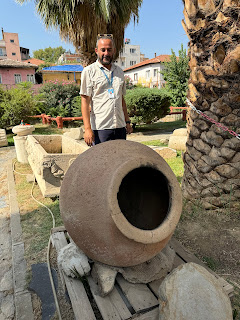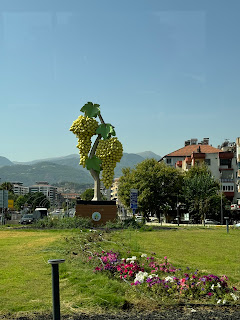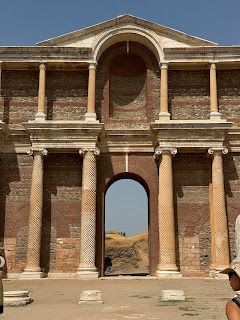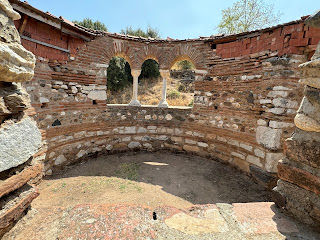A Journey To Find Brotherly Love
We departed from Doga Thermal Health & Spa, a sanctuary of tranquility, embarking on a journey into the heart of ancient history. Alaşehir, the city of brotherly love, awaited us, a tapestry woven with threads of the past.
The drive to Alaşehir was a journey through time itself, a transition from the serene embrace of nature to the bustling energy of a city steeped in history. Alaşehir, a charming blend of ancient ruins and modern-day charm, offered a glimpse into the past and present.
The ruins of ancient Philadelphia, founded by King Attalus II Philadelphus, were a testament to the city's rich history. As we explored the archaeological sites, I couldn't help but marvel at the ingenuity and craftsmanship of the ancient inhabitants.
Lydia, the powerful kingdom that once encompassed Alaşehir, left an indelible mark on the region. King Croesus, a legendary ruler of Lydia, was renowned for his immense wealth and patronage of the arts. The Lydian coinage system, a testament to their economic prowess, revolutionized trade in the ancient world.
The journey continued, taking us past thermal power plants, a stark contrast to the ancient ruins we had explored. The debate surrounding these power plants, a balancing act between energy needs and environmental concerns, was a reminder of the challenges faced by modern society.
As we approached Sardis, the ancient capital of Lydia, anticipation built within me. This city, once a bustling metropolis, promised a glimpse into the opulence and grandeur of the past.
A Detour Through Vineyards and Ruins
As we approached Sardis, the ancient city beckoning in the distance, a fortuitous detour led us to a roadside vendor. The woman, a guardian of the region's agricultural treasures, offered us a taste of the local Sultan grapes (she has the Lady Fingers variant too). Unable to resist, we stopped and savored the grapes, their small size and delicate sweetness a delightful contrast to the arid landscape.
I couldn't help but purchase a kilo of cucumbers, their diminutive size a stark contrast to what I was accustomed to. However, their refreshing crispness was a delightful surprise. A sprinkle of salt, I was told, would elevate their flavor even further.
These encounters, small moments amidst our journey, revealed the richness of the region's produce and the warmth of its people.
The Church of Philadelphia, a beacon of faith amidst the ruins, awaited us. This sacred edifice, once praised by Jesus Himself, stood as a testament to the enduring power of belief. Three pillars, remnants of a once-grand structure, stood as silent sentinels. These pillars, I mused, were metaphors for enduring love, their presence a testament to the resilience of faith.
Scattered around the church were epitaphs, inscribed in Greek, Armenian, and Turkish, the echoes of lives long past. Our guide, Babur, shared the chilling tale of sarcophagi, their accelerated decomposition a stark contrast to their intended purpose.
The pithos, a clay jar, some capable of holding more than a thousand liters, was another fascinating revelation. This simple vessel, a symbol of ancient ingenuity, had served as a dwelling for the enigmatic philosopher Diogenes of Sinope, who sought to live a simple life.
Reference: https://www.bible.com/bible/111/REV.3.7-13
As we continued our journey, the landscape transformed, revealing the ancient city of Sardis in all its glory. As we depart the city centre, an installation of grapes hints at their adoration of Dionysus, the Greek god of wine, revelry, and festivity.
Unlikely Pairing: Synagogue and Gymnasium
The synagogue, a colossal structure, stood as a testament to the enduring spirit of the Jewish community in Sardis. Its restoration, a labor of love, promised to unveil the secrets of this ancient sanctuary. The mosaic floor, a masterpiece of artistry, hinted at the vibrant tapestry of life within these hallowed walls.
As I wandered through the ruins, I couldn't help but ponder the lives of those who had walked these same paths centuries ago. The synagogue, a symbol of resilience, stood as a testament to the enduring power of faith.
The gymnasium, a cornerstone of ancient Sardis, offered a glimpse into the dynamic lives of its inhabitants. The palaestra, the gymnasium, the baths, and the lecture halls were more than mere structures; they were spaces where minds were honed, bodies strengthened, and social bonds forged.
Public Bath and Roman Luxury
The baths at Sardis, a testament to Roman opulence, invited a journey into the past. The elevated platform, a central feature of these bathing complexes, provided a unique and luxurious experience. Visitors could relax and soak in the warm waters, enjoying the soothing effects and the stunning views of the surrounding area.
The apodyterium, the changing room, was where visitors could prepare for their bathing experience. The tepidarium, a warm room, allowed them to acclimate to the temperature before entering the calidarium, the hot room where they could relax and sweat. The frigidarium, a cold plunge pool, was used for cooling down after the hot bath. The natatio, a swimming pool, offered an opportunity for exercise and recreation.
These bathing areas were often decorated with mosaics, frescoes, and sculptures, showcasing the artistic skills of the Romans. Some baths also included libraries, lecture halls, and gardens, providing a variety of activities for visitors.
The baths at Sardis were likely an important part of the social and cultural life of the city, serving as places for relaxation, socializing, and health benefits. The remains of these baths provide valuable insights into the daily life and architectural styles of the Roman era.
As I explored the ruins, I couldn't help but again wonder about the lives of those who had frequented these spaces. Who had bathed in these pools? Who had engaged in athletic pursuits within these walls? Who had sought solace and wisdom in the libraries and lecture halls?
The synagogue, the gymnasium, the baths – these were more than just structures; they were living, breathing spaces, filled with the energy and vitality of the people who had once inhabited them. As I wandered through the ruins, I felt a connection to the past, a sense of awe and wonder at the enduring legacy of these ancient places.
A Story of Two Faiths
The road to Temple of Artemis, a pilgrimage to the heart of antiquity, unfolded before us. This temple, a sentinel perched upon the Acropolis, awaited our arrival. The remnants of excavation machinery, a testament to the relentless pursuit of knowledge, lay scattered around the site.
Our guide, a repository of historical lore, painted a vivid picture of the temple's grandeur. Its construction, an ambitious undertaking, had remained incomplete, a testament to the challenges faced by its ancient builders.
The temple, a masterpiece of architecture, offered a breathtaking panorama. The valley below, a tapestry of green, was framed by the majestic peaks of the surrounding mountains. The river Cayster, a sinuous ribbon of silver, meandered through the landscape, a testament to nature's enduring beauty.
My mind, a whirlwind of questions, pondered the politics of the era. Who were the temple's protectors? How had they defended their sacred sanctuary against the tides of time and conflict?
A chapel, a testament to the enduring spirit of faith, stood adjacent to the temple ruins. Its presence, a juxtaposition of the ancient and the modern, raised intriguing questions. Why had the Christians chosen to preserve this symbol of a rival faith?
As we explored the surrounding area, right outside the museum gate, the bounty of the land revealed itself. Grapes, drying in the sun, promised a sweet reward. Figs, plucked from a nearby tree, offered a taste of nature's generosity. The simplicity of these pleasures, a stark contrast to the complexities of history, filled me with a sense of contentment.
Bin Tepe: A Necropolis of Ancient Sardis
Bin Tepe, a vast necropolis just north of Sardis, offers a glimpse into the ancient Lydians' burial practices. This sprawling cemetery houses over 100 tumuli, or burial mounds, some of which are among the largest in the world. These imposing structures, often adorned with stone carvings or statues, were built to commemorate the deceased and their social standing.
The most prominent tumulus is that of Alyattes, King of Lydia. This colossal mound, rivaling the pyramids of Giza in size, reflects the opulence and power of Lydian rulers. Although the tomb was plundered in antiquity, its sheer scale and imposing presence continue to captivate visitors.
Even without visiting Bin Tepe in person, our guide's stories transported us back to the ancient world. We imagined the vast necropolis, the imposing tumuli, and the lives of the people who once inhabited this region.
A Culinary Detour and a Seaside Stroll
Our journey to Ephesus was punctuated by a pit stop, a culinary interlude that offered a taste of local fare. The kebabs, a simple yet satisfying delight, provided a respite from the rigors of travel.
Kuşadası, a town transformed, awaited us. Our guide, a native son, shared tales of its metamorphosis, the population swelling from a modest fifteen thousand to a bustling two hundred thousand. The sentiment resonated, a familiar echo of the displacement that accompanies urban growth.
As we settled into our hotel room, I retreated into the world of words, my fingers dancing across the keyboard. Yit Peng and Shiqin, drawn by the allure of the Aegean Sea, sought refreshment in its cool embrace. The heat, a relentless adversary, deterred me from joining their aquatic pursuits.
The evening, a tapestry of culinary mediocrity and seaside charm, unfolded. The dinner, a forgettable affair, was quickly forgotten as we ventured into the heart of Kuşadası. A leisurely stroll along the coast, the sea breeze a soothing balm against the oppressive heat, provided a delightful conclusion to the day.



























































No comments:
Post a Comment